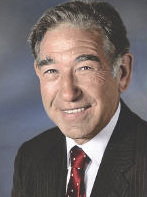Stanley Cohen(November 17, 1922 – February 5, 2020) was an American biochemist who, along withRita Levi-Montalcini,was awarded theNobel PrizeinPhysiology or Medicinein 1986 for the isolation ofnerve growth factorand the discovery ofepidermal growth factor.He died in February 2020 at the age of 97.[3][4]
Stanley Cohen | |
|---|---|
 | |
| Born | November 17, 1922 |
| Died | February 5, 2020(aged 97) |
| Education | University of Michigan Oberlin College Brooklyn College |
| Known for | Nerve growth factor |
| Awards | Rosenstiel Award(1981) Louisa Gross Horwitz Prize(1983) Albert Lasker Award for Basic Medical Research(1986) Nobel Prize in Physiology or Medicine(1986) Franklin Medal(1987) |
| Scientific career | |
| Fields | Biochemistry |
| Institutions | Vanderbilt University(1959–1999) Washington University in St. Louis(1953–1959) |
| Thesis | The Nitrogenous Metabolism of the Earthworm(1949) |
| Doctoral advisor | Howard B. Lewis[1][2] |
Early life and education
editCohen was born in Brooklyn, New York, on November 17, 1922. He was the son of Fannie (née Feitel) and Louis Cohen, a tailor.[5][6]His parents wereJewishimmigrants.[7]Cohen received hisbachelor's degreein 1943 fromBrooklyn College,where he had double-majored inchemistryandbiology.After working as abacteriologistat a milk processing plant to earn money, he received hisMaster of ArtsinzoologyfromOberlin Collegein 1945. He earned adoctoratefrom the department of biochemistry about the metabolism of earthworms at theUniversity of Michiganin 1948.[8]
Career
editHis first academic employment was at the University of Colorado studying the metabolism of premature babies. In 1952 he moved toWashington University in St. Louis,working first in the department of radiology, learning isotope methodology, and then in the department of zoology. Working withRita Levi-Montalcini,he isolated nerve growth factor. He later isolated a protein that could accelerate incisor eruption and eyelid opening in newborn mice,[9]which was renamed epidermal growth factor.[10]He continued research on cellular growth factors after joining the faculty ofVanderbilt University School of Medicinein 1959.[8]
In 1999, Cohen retired from Vanderbilt University.[11]
Awards and legacy
editCohen received theLouisa Gross Horwitz PrizefromColumbia Universitytogether with Rita Levi-Montalcini in 1983, theNobel PrizeinPhysiology or Medicinein 1986 for the isolation ofnerve growth factorand the discovery ofepidermal growth factorand theNational Medal of Sciencein 1986.[12][13][14][15] His research on cellular growth factors has proven fundamental to understanding the development ofcancerand designing anti-cancer drugs.
See also
editReferences
edit- ^Cohen, S.;Lewis, H. B. (1949)."The nitrogenous metabolism of the earthworm (Lumbricus terrestris)".The Journal of Biological Chemistry.180(1):79–91.doi:10.1016/S0021-9258(18)56725-9.PMID18133376.
- ^Cohen, S.;Lewis, H. B. (1950)."The nitrogenous metabolism of the earthworm (Lumbricus terrestric). II. Arginase and urea synthesis".The Journal of Biological Chemistry.184(2):479–484.doi:10.1016/S0021-9258(19)50977-2.PMID15428427.
- ^"Biochemist and Nobel Prize winner Stanley Cohen dies in Nashville at age 97".
- ^Glaser, Vicki (7 February 2020)."Stanley Cohen, Nobelist, Dies at 97; Made Breakthrough on Cell Growth".The New York Times.
- ^Stanley Cohen Biography.Archivedfrom the original on 17 November 2017.Retrieved6 May2018– via www.bookrags.com.
- ^Sleeman, Elizabeth, ed. (2003).The international who's who 2004(67th ed.). London: Europa. p. 339.ISBN978-1857432176.Retrieved4 May2016.
- ^Fox, Daniel M.; Meldrum, Marcia; Rezak, Ira (2019-01-15).Nobel Laureates in Medicine or Physiology: A Biographical Dictionary.Routledge.ISBN9780429665035.
- ^ab"The Nobel Prize in Physiology or Medicine 1986".NobelPrize.org.Retrieved2024-02-17.
- ^Watts, Geoff (March 2020)."Stanley Cohen".The Lancet.395(10227): 864.doi:10.1016/S0140-6736(20)30550-X.
- ^Carpenter, G.;Cohen, S.(1979). "Epidermal Growth Factor".Annual Review of Biochemistry.48:193–216.doi:10.1146/annurev.bi.48.070179.001205.PMID382984.
- ^"Cohen's visit brings alive wonder, power of science (12/7/07)".www.mc.vanderbilt.edu.Archived fromthe originalon 2020-07-28.Retrieved2019-11-17.
- ^Cohen, Stanley (1993)."Epidermal Growth Factor"(PDF).In Tore Frängsmyr; Jan Lindsten (eds.).Nobel Lectures, Physiology or Medicine 1981–1990.Singapore: World Scientific Publishing Co.ISBN978-981-02-0793-9.Archived(PDF)from the original on 2010-12-15.Cohen's Nobel Lecture.
- ^Raju, T. N. (2000). "The Nobel chronicles. 1986: Stanley Cohen Cohen (b 1922); Rita Levi-Montalcini (b 1909)".Lancet.355(9202): 506.doi:10.1016/S0140-6736(00)82069-3.PMID10841166.S2CID54340580.
- ^Shampo, M. A.; Kyle, R. A. (1999)."Stanley Cohen—Nobel Laureate for Growth Factor".Mayo Clinic Proceedings.74(6): 600.doi:10.4065/74.6.600.PMID10377936.
- ^Weltman, J. K. (1987). "The 1986 Nobel Prize for Physiology or Medicine awarded for discovery of growth factors: Rita Levi-Montalcini, M.D., and Stanley Cohen, Ph.D".New England and Regional Allergy Proceedings.8(1):47–48.doi:10.2500/108854187779045385.PMID3302667.
- ^"Cohen, Stanley N."Retrieved1 March2020.
External links
edit- Media related toStanley Cohen (biochemist)at Wikimedia Commons
- Stanley Cohenon Nobelprize.orgincluding the Nobel Lecture 8 December 1986Epidermal Growth Factor
- Stanley Cohen Nobel link
- The Official Site of Louisa Gross Horwitz Prize